Category: Class 9
Molecular Weight Of Hydrogen
Molecular Weight Of Hydrogen: Hydrogen, the simplest and most abundant element in the universe, plays a fundamental role in the realm of chemistry and beyond.
To comprehend its properties and interactions, scientists employ various concepts, one of which is the molecular weight. In this article, we explore the molecular weight of hydrogen, shedding light on its significance and applications in the world of science.
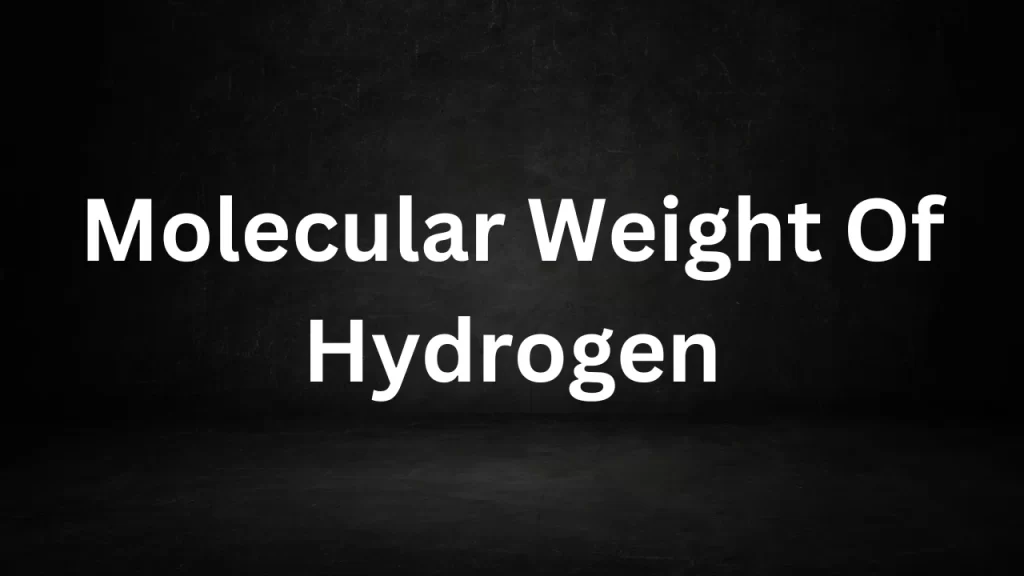
Molecular Weight Of Hydrogen
1. Understanding Molecular Weight
Molecular weight, also known as molar mass, refers to the mass of a molecule expressed in atomic mass units (amu) or grams per mole (g/mol). It is a crucial concept in chemistry, enabling scientists to quantify the amount of a substance by mass rather than by the number of atoms or molecules, making it a valuable tool in chemical calculations.
2. The Hydrogen Molecule (H₂)
In the case of hydrogen, the molecular weight is calculated based on the diatomic molecule H₂. Each molecule consists of two hydrogen atoms (H), and the atomic weight of hydrogen is approximately 1.008 amu. To determine the molecular weight of H₂, we add the atomic weights of its constituent atoms:
Molecular Weight of H₂ = 2 × Atomic Weight of Hydrogen ≈ 2.016 g/mol
Therefore, the molecular weight of hydrogen gas (H₂) is approximately 2.016 grams per mole (g/mol).
3. The Significance of Hydrogen’s Low Molecular Weight
Hydrogen’s exceptionally low molecular weight is one of its defining characteristics. It is not only the lightest element but also the lightest molecule. This low molecular weight contributes to several remarkable properties and applications:
- Efficient Fuel: Hydrogen’s low molecular weight makes it an excellent fuel source for rockets and combustion engines. Its combustion produces a high amount of energy per unit mass, making it an ideal choice for space exploration and fuel cells.
- Buoyant Gas: Hydrogen is lighter than air, which makes it an efficient lifting gas. In the early days of aviation, hydrogen-filled airships (such as the Hindenburg) were used for transportation, although its flammability posed significant safety concerns.
- Chemical Reactivity: Due to its low molecular weight, hydrogen gas exhibits high chemical reactivity. It readily reacts with various elements, including oxygen, forming water (H₂O) in combustion reactions.
4. Hydrogen Isotope Variants
It’s essential to note that hydrogen has three isotopes, each with different atomic weights: protium (¹H), deuterium (²H or D), and tritium (³H or T). Protium is the most common and abundant isotope, making up approximately 99.98% of naturally occurring hydrogen. Deuterium is a stable isotope, while tritium is radioactive.
- The molecular weight of hydrogen gas (H₂) primarily accounts for the protium isotope. Deuterium, which is twice as heavy as protium, results in a slightly higher molecular weight when present in hydrogen molecules.
5. Applications Beyond Chemistry
The mol weight of hydrogen extends its importance beyond the realm of chemistry:
- Energy Production: Hydrogen holds promise as a clean and sustainable energy carrier. It can be used in fuel cells to generate electricity, producing water as the only byproduct.
- Space Exploration: Hydrogen is a critical component of rocket fuels used in space exploration due to its high energy content and low molecular weight.
- Alternative Fuel: In the context of addressing environmental concerns, hydrogen is being explored as a potential alternative to fossil fuels in transportation and industry.
6. Conclusion
The mol weight of hydrogen, approximately 2.016 g/mol, is a fundamental property that characterizes this element’s diatomic molecule, H₂. Its lightweight nature contributes to its versatile applications in energy production, space exploration, and emerging technologies aimed at a sustainable future. Understanding the mol weight of hydrogen is essential for harnessing its potential as an efficient and clean energy source and for advancing our understanding of the universe at its most basic level.
Read More
- Molecular Weight Of Hydrogen
- Molecular Weight Of Urea
- Molecular Mass Of Urea
- Molecular Mass Of Hydrogen
- Molecular Mass Of Nacl
Frequently Asked Questions (FAQs) Molecular Weight Of Hydrogen
1. What is the molecular weight of hydrogen?
The mol weight of hydrogen is approximately 2.016 grams per mole (g/mol). This value represents the mass of one mole of hydrogen molecules (H₂), with each molecule consisting of two hydrogen atoms.
2. How is the molecular weight of hydrogen calculated?
The mol weight of hydrogen is calculated by adding the atomic weights of its constituent atoms. The atomic weight of hydrogen is approximately 1.008 amu (atomic mass units). Since one molecule of hydrogen (H₂) contains two hydrogen atoms, you sum the atomic weights as follows: 1.008 amu + 1.008 amu ≈ 2.016 g/mol.
3. Why is hydrogen’s molecular weight important in chemistry?
Hydrogen’s low mol weight is significant because it affects its physical and chemical properties. It makes hydrogen an efficient fuel, a buoyant gas, and a highly reactive element in various chemical reactions. Understanding its molecular weight is crucial for applications in energy, space exploration, and chemistry.
4. How does hydrogen’s molecular weight compare to other elements?
Hydrogen has the lowest molecular weight of all elements. This low mass makes it exceptionally lightweight and has practical implications, such as its use in hydrogen fuel cells and its historical use in airships.
5. Is the molecular weight of hydrogen affected by its isotopes?
Yes, the mol weight of hydrogen can be affected by its isotopes. Hydrogen has three isotopes: protium (¹H), deuterium (²H or D), and tritium (³H or T). While the mol weight primarily considers the protium isotope, the presence of deuterium in hydrogen molecules (known as heavy hydrogen) can slightly increase the mol weight due to its higher atomic weight.
Molecular Weight Of Sulphur
Molecular Weight Of Sulphur: Sulphur, a non-metal element with the chemical symbol “S” and atomic number 16, is an essential element in the periodic table. It plays various critical roles in chemistry, industry, and biology.
One fundamental property of any chemical element is its molecular weight, which provides insight into its behavior and significance. In this article, we will delve into the molecular weight of sulphur and its implications in different contexts.

Molecular Weight Of Sulphur
Understanding Molecular Weight
Molecular weight, also known as mol mass or molar mass, is a fundamental concept in chemistry. It represents the mass of a molecule or an element expressed in atomic mass units (u) or unified atomic mass units (AMU). Molecular weight is calculated by summing the atomic masses of all the atoms in a molecule.
The Atomic Mass of Sulphur
Before calculating the mol weight of sulphur, let’s consider the atomic mass of a sulphur atom. The atomic mass of sulphur (S) is approximately 32.06 atomic mass units (u). This value is an average of the isotopes of sulphur found in nature, which have slightly different masses due to variations in the number of neutrons.
Calculating the Molecular Weight of Sulphur
Sulphur typically exists as S8 molecules, where eight sulphur atoms are chemically bonded together to form a molecule. To calculate the mol weight of sulphur (S8), we simply multiply the atomic mass of sulphur by the number of sulphur atoms in a molecule:
mol Weight of Sulphur (S8) = Atomic Mass of Sulphur (S) × Number of Sulphur Atoms
mol Weight of Sulphur (S8) = 32.06 u × 8
mol Weight of Sulphur (S8) = 256.48 u
Rounded to two decimal places, the mol weight of sulphur (S8) is approximately 256.48 atomic mass units (u).
Significance of Sulphur’s Molecular Weight
Understanding the molecular weight of sulphur is important in various scientific and industrial applications:
- Chemical Reactions: Sulphur is involved in many chemical reactions and forms compounds with other elements. Knowledge of its molecular weight is essential for stoichiometry calculations and determining reaction products.
- Industrial Processes: Sulphur is used in various industrial processes, including the production of sulfuric acid, fertilizers, and rubber vulcanization. Its molecular weight is critical for quality control and process optimization.
- Environmental Impact: Sulphur compounds contribute to environmental issues such as acid rain and air pollution. Monitoring the molecular weight of sulphur-containing compounds helps assess their impact.
- Geological Exploration: Sulphur deposits are important resources in mining and geology. Accurate measurements of sulphur’s molecular weight aid in resource assessment and extraction.
- Biological Functions: Sulphur is a vital element in biological molecules like amino acids and vitamins. Its molecular weight is relevant in understanding biochemical processes.
- Materials Science: Sulphur is used in materials science for applications such as vulcanizing rubber and creating sulfur polymers. Molecular weight is a critical factor in material properties.
In conclusion, the mol weight of sulphur, approximately 256.48 atomic mass units (u) for S8 molecules, is a fundamental property of this element. It plays a pivotal role in various scientific, industrial, and environmental contexts, reflecting the versatility and importance of sulphur in our world.
Read More
- Molecular Weight Of Urea
- Molecular Mass Of Urea
- Molecular Mass Of Hydrogen
- Molecular Mass Of Nacl
- Molecular Mass Of Naoh
Frequently Asked Question (FAQs) Molecular Weight Of Sulphur
1. What is the molecular weight of sulphur?
The mol weight of sulphur (S) is approximately 32.06 atomic mass units (u) or unified atomic mass units (AMU). This value represents the average atomic mass of sulphur isotopes found in nature.
2. How is the molecular weight of sulphur calculated?
The mol weight of sulphur is calculated by summing the atomic masses of all the sulphur atoms in a molecule. Sulphur typically exists as S8 molecules, so the molecular weight of sulphur (S8) is 8 times the atomic mass of a sulphur atom.
3. Why is the molecular weight of sulphur important in chemistry?
The mol weight of sulphur is a fundamental property used in stoichiometry calculations, chemical reactions, and determining the composition of sulphur-containing compounds. It helps chemists understand the behavior of sulphur in various contexts.
4. How is sulphur used in industrial processes, and why does its molecular weight matter?
Sulphur is used in industrial processes, such as the production of sulfuric acid and fertilizers. Its mol weight is crucial for process optimization, quality control, and determining the amount of sulphur required in reactions.
5. What is the environmental impact of sulphur compounds, and how does molecular weight relate to it?
Sulphur compounds can contribute to environmental issues like acid rain and air pollution. Monitoring the mol weight of sulphur-containing compounds helps assess their environmental impact and regulation.
Molecular Weight Of Urea
Molecular Weight Of Urea: The molecular weight of urea (NH₂)₂CO can be calculated by summing the atomic weights of its constituent elements. Here are the atomic weights of the elements in urea:

Molecular Weight Of Urea
Molecular Weight: A Fundamental Concept
Molecular weight is the mass of a molecule expressed in atomic mass units (u) or unified atomic mass units (AMU). It is defined as the sum of the atomic masses of all the atoms in a molecule. Molecular weight is a vital parameter in chemistry because it helps us determine the quantity of a substance, calculate reaction stoichiometry, and understand the physical and chemical properties of compounds.
The Composition of Urea
Urea, with the chemical formula (NH₂)₂CO, is an organic compound found in many living organisms and is also synthetically produced for various purposes. Let’s break down the atomic composition of urea:
- Nitrogen (N): Atomic weight ≈ 14.00674 u.
- Hydrogen (H): Atomic weight ≈ 1.00784 u.
- Carbon (C): Atomic weight ≈ 12.0096 u.
- Oxygen (O): Atomic weight ≈ 15.999 u.
Calculating the Molecular Weight of Urea
To calculate the molecular weight of urea, we sum the atomic weights of all its constituent elements:
Molecular Weight of Urea = (2 × Atomic Weight of N) + (4 × Atomic Weight of H) + Atomic Weight of C + (2 × Atomic Weight of O)
Molecular Weight of Urea ≈ (2 × 14.00674 u) + (4 × 1.00784 u) + 12.0096 u + (2 × 15.999 u)
Molecular Weight of Urea ≈ 28.01348 u + 4.03136 u + 12.0096 u + 31.9998 u
Molecular Weight of Urea ≈ 76.05224 u
Rounded to four decimal places, the molecular weight of urea is approximately 76.0522 atomic mass units (u).
Significance of Urea’s Molecular Weight
Understanding the molecular weight of urea holds significance in various fields and applications:
- Agriculture: Urea is a common nitrogen-rich fertilizer used in agriculture. Its molecular weight is crucial for determining the quantity of nitrogen applied to crops, influencing their growth and yield.
- Chemical Reactions: In chemical reactions involving urea, its molecular weight is vital for stoichiometry calculations, allowing chemists to determine the amounts of H2NCONH2 required or produced.
- Biochemistry: Urea plays a role in biochemical processes, such as the urea cycle, which eliminates excess nitrogen from the body. Molecular weight is essential in metabolic studies and medical diagnostics.
- Industrial Applications: Urea has industrial applications, including its use in plastics, adhesives, and textiles. Its molecular weight is relevant in quality control and manufacturing processes.
- Medicine: Urea is used in medical tests, like the urea breath test, for diagnosing certain conditions. Understanding its molecular weight is vital for accurate diagnostic procedures.
Conclusion
The molecular weight of H2NCONH2, approximately 76.0522 atomic mass units (u), is a fundamental property of this versatile organic compound. Whether in agriculture, chemistry, biochemistry, industry, or healthcare, knowledge of urea’s molecular weight enhances our understanding of its applications and importance in different aspects of our lives. It serves as a reminder of the critical role molecular weight plays in chemistry and its practical implications in diverse fields.
Read More
- Molecular Mass Of Urea
- Molecular Mass Of Hydrogen
- Molecular Mass Of Nacl
- Molecular Mass Of Naoh
- Molecular Mass Of Nitrogen
Frequently Asked Question (FAQs) Molecular Weight Of H2NCONH2
1. What is the molecular weight of H2NCONH2?
The molecular weight of urea (NH₂)₂CO is approximately 76.0522 atomic mass units (u). This value is calculated by summing the atomic weights of the constituent elements in the molecule: nitrogen (N), hydrogen (H), carbon (C), and oxygen (O).
2. Why is the molecular weight of H2NCONH2 important in chemistry?
The molecular weight of H2NCONH2 is a fundamental property that helps chemists determine the quantity of H2NCONH2 in reactions, calculate stoichiometry, and understand its behavior in various chemical processes.
3. How is the molecular weight of H2NCONH2 calculated?
The molecular weight of H2NCONH2 is calculated by adding the atomic weights of its constituent elements. This includes two nitrogen atoms (N), four hydrogen atoms (H), one carbon atom (C), and two oxygen atoms (O).
4. What is the significance of urea’s molecular weight in agriculture?
Urea is a common nitrogen-rich fertilizer used in agriculture. Its molecular weight is crucial for calculating the amount of nitrogen applied to crops, which directly affects their growth and yield.
5. Are there any biochemical implications of urea’s molecular weight?
Urea plays a role in biochemical processes, such as the urea cycle, which helps eliminate excess nitrogen from the body. Understanding urea’s molecular weight is important for metabolic studies and medical diagnostics.
Molecular Mass Of Urea
Molecular Mass Of Urea: Urea, a simple but essential organic compound, holds a prominent place in the fields of biology, chemistry, and agriculture.
Understanding the molecular mass of urea is fundamental to grasp its role in various applications, from fertilizers to biochemical processes. In this article, we will delve into the molecular mass of urea and explore its significance.

Molecular Mass Of Urea
The Basics of Molecular Mass
Molecular mass, also known as molecular weight or molar mass, is a key concept in chemistry. It represents the mass of a molecule and is typically expressed in atomic mass units (u) or unified atomic mass units (AMU). Molecular mass is calculated by summing the atomic masses of all the atoms in a molecule.
Urea: A Common Organic Compound
Urea, with the chemical formula (NH₂)₂CO, is a naturally occurring organic compound. It is a byproduct of protein metabolism in animals and is also synthetically produced for various purposes, including as a nitrogen-rich fertilizer.
Atomic Mass of Urea
To calculate the molecular mass of urea, we need to consider the individual atomic masses of the constituent elements:
- The atomic mass of nitrogen (N) is approximately 14.00674 atomic mass units (u).
- The atomic mass of hydrogen (H) is approximately 1.00784 u.
- The atomic mass of carbon (C) is approximately 12.0096 u.
- The atomic mass of oxygen (O) is approximately 15.999 u.
Calculating the Molecular Mass of Urea
Now, let’s calculate the molecular mass of H2NCONH2 by summing the atomic masses of its constituent elements:
Molecular Mass of H2NCONH2 = (2 x Atomic Mass of N) + (4 x Atomic Mass of H) + Atomic Mass of C + (2 x Atomic Mass of O)
Molecular Mass of Urea ≈ (2 x 14.00674 u) + (4 x 1.00784 u) + 12.0096 u + (2 x 15.999 u)
Molecular Mass of Urea ≈ 28.01348 u + 4.03136 u + 12.0096 u + 31.998 u
Molecular Mass of Urea ≈ 76.05244 u
Rounded to four decimal places, the molecular mass of urea is approximately 76.0524 atomic mass units (u).
Significance of Urea’s Molecular Mass
Understanding the molecular mass of urea is crucial in various scientific and practical contexts:
- Agriculture: Urea is a widely used nitrogen fertilizer in agriculture. Its molecular mass is important for determining the amount of nitrogen supplied to plants for optimal growth and crop yield.
- Biochemistry: Urea plays a significant role in biochemical processes, such as the urea cycle, which is responsible for the elimination of excess nitrogen from the human body. Knowledge of urea’s molecular mass is essential in these processes.
- Chemical Reactions: In laboratory settings, urea is used in chemical reactions and as a denaturant in protein studies. Its molecular mass is a key factor in reaction stoichiometry and experimental design.
- Industrial Applications: Urea has applications in various industries, including textiles, adhesives, and plastics. Its molecular mass is important in quality control and manufacturing processes.
- Medicine: Urea is used in some medical tests, such as the urea breath test for diagnosing Helicobacter pylori infections. Understanding urea’s molecular mass is essential for accurate diagnostic procedures.
Conclusion
The molecular mass of urea, approximately 76.0524 atomic mass units (u), is a fundamental property of this versatile organic compound.
Its significance spans agriculture, biochemistry, industry, and healthcare. Whether you’re a farmer, chemist, biologist, or researcher, an awareness of urea’s molecular mass enhances your understanding of its applications and importance in various aspects of our world.
Read More
- Molecular Mass Of Hydrogen
- Molecular Mass Of Nacl
- Molecular Mass Of Naoh
- Molecular Mass Of Nitrogen
- Molecular Weight Of Glucose
Frequently Asked Questions (FAQs) Molecular Mass Of H2NCONH2
1. What is the molecular mass of urea?
The molecular mass of urea (NH₂)₂CO is approximately 76.0524 atomic mass units (u). This value is obtained by summing the atomic masses of the constituent elements in the molecule: nitrogen (N), hydrogen (H), carbon (C), and oxygen (O).
2. Why is it important to know the molecular mass of H2NCONH2?
Understanding the molecular mass of H2NCONH2 is crucial in various scientific, agricultural, and industrial applications. It helps in fertilizer formulation, biochemical studies, chemical reactions, and medical diagnostics.
3. How is the molecular mass of H2NCONH2 calculated?
The molecular mass of H2NCONH2 is calculated by adding the atomic masses of its constituent elements. This includes two nitrogen atoms (N), four hydrogen atoms (H), one carbon atom (C), and two oxygen atoms (O).
4. What is the significance of urea’s molecular mass in agriculture?
Urea is a commonly used nitrogen fertilizer in agriculture. Its molecular mass is essential for determining the amount of nitrogen supplied to plants, which affects their growth and crop yield.
5. How is urea used in biochemical processes?
Urea is involved in biochemical processes such as the urea cycle, which helps eliminate excess nitrogen from the human body. Understanding its molecular mass is important for metabolic studies and medical diagnostics.
Molecular Mass Of Hydrogen
Molecular Mass Of Hydrogen: H2, the lightest and most abundant element in the universe, plays a fundamental role in chemistry, physics, and astrophysics.
One key aspect of H2 is its molecular mass, a concept that underpins our understanding of chemical reactions, gas properties, and the composition of matter. In this article, we will explore the molecular mass of H2 and its significance.
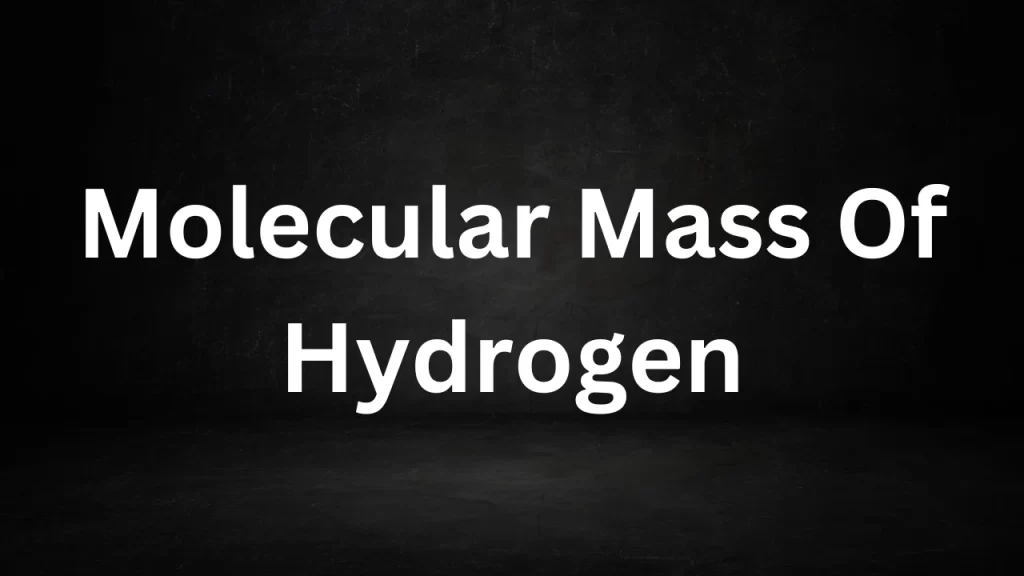
Molecular Mass Of Hydrogen
The Basics of Molecular Mass
Molecular mass, also known as molecular weight or molar mass, is a crucial concept in chemistry. It represents the mass of a molecule and is typically expressed in atomic mass units (u) or unified atomic mass units (AMU). Molecular mass is calculated by summing the atomic masses of all the atoms in a molecule.
Hydrogen: The Simplest Element
H2 is the simplest and lightest element in the periodic table. It has an atomic number of 1, indicating that it has one proton in its nucleus. The most common and stable form of hydrogen is the diatomic molecule H2, where two hydrogen atoms are chemically bonded together.
Atomic Mass of Hydrogen
The atomic mass of H2 is approximately 1.00784 atomic mass units (u). This value accounts for the most common isotope of hydrogen, known as protium (¹H), which consists of one proton and one electron.
Calculating the Molecular Mass of Hydrogen (H2)
To calculate the molecular mass of hydrogen (H2), we simply add the atomic masses of the two hydrogen atoms in the molecule:
Molecular Mass of Hydrogen (H2) = (Atomic Mass of H2) x 2 Molecular Mass of Hydrogen (H2) ≈ (1.00784 u) x 2 ≈ 2.01588 u
Rounded to four decimal places, the molecular mass of hydrogen (H2) is approximately 2.0159 atomic mass units (u).
Significance of Hydrogen’s Molecular Mass
Understanding the molecular mass of H2 is of paramount importance in various scientific and practical contexts:
- Chemical Reactions: In chemical reactions involving hydrogen, its molecular mass is crucial for stoichiometry calculations. It helps determine the amount of H2 required or produced in a reaction.
- Gas Properties: H2 is used as a fuel and in gas mixtures for various applications. Its molecular mass influences its behavior as a gas, including density, solubility, and combustion properties.
- Energy Storage: Hydrogen is considered a clean and efficient energy carrier. Its molecular mass affects the energy density of hydrogen fuels and their storage and transportation.
- Astrophysics: Understanding the molecular mass of H2 is vital in astrophysics, where H2 is the primary element in stars and the universe’s most abundant element.
- H2 Bonding: H2 bonds with other elements and molecules, and its molecular mass influences the strength and characteristics of these bonds.
- Fuel Cells: In H2 fuel cells, which are used for power generation and transportation, the molecular mass of H2 plays a role in efficiency calculations.
Conclusion
The molecular mass of hydrogen (H2), approximately 2.0159 atomic mass units (u), is a fundamental property of this elemental gas. Its significance extends from the microscopic world of chemical reactions to the vast reaches of the universe in astrophysics. Whether it’s powering vehicles, fueling stars, or driving chemical reactions in the laboratory, the molecular mass of H2 is a foundational concept that enriches our understanding of the physical and chemical properties of matter.
Read More
- Molecular Mass Of Nacl
- Molecular Mass Of Naoh
- Molecular Mass Of Nitrogen
- Molecular Weight Of Glucose
- Molecular Mass Of Oxygen
Frequently Asked Question (FAQs) Molecular Mass Of H2
1. What is the molecular mass of hydrogen (H2)?
The molecular mass of hydrogen (H2) is approximately 2.0159 atomic mass units (u). This value is calculated by adding the atomic masses of the two H2 atoms in the molecule.
2. Why is the molecular mass of H2 significant?
The molecular mass of H2 is essential in various scientific fields, including chemistry, physics, and astrophysics. It influences chemical reactions, gas properties, energy storage, and our understanding of the universe.
3. How is the molecular mass of H2 calculated?
The molecular mass of hydrogen (H2) is calculated by multiplying the atomic mass of H2 by 2, as there are two H2 atoms in the H2 molecule. The atomic mass of H2 is approximately 1.00784 atomic mass units (u).
4. What are the implications of H2 molecular mass in chemical reactions?
Hydrogen’s molecular mass is crucial in stoichiometry calculations, helping determine the quantities of H2 involved in chemical reactions. It plays a fundamental role in chemical synthesis and analysis.
5. How does H2 molecular mass affect its behavior as a gas?
Hydrogen’s molecular mass influences its gas properties, including density, solubility, and combustion characteristics. It is used as a fuel in various applications due to its low molecular mass and high energy content.
Molecular Mass Of Nacl
Molecular Mass Of Nacl: Sodium chloride, commonly known as NaCl, is a ubiquitous chemical compound that holds a prominent place in both our culinary and scientific worlds.
Its molecular mass, often overlooked in daily life, plays a crucial role in various scientific, industrial, and health-related contexts. Let’s delve into the fundamentals of the molecular mass of NaCl and explore its significance.

Molecular Mass Of Nacl
Molecular Mass: The Foundation
Before we delve into the molecular mass of NaCl, it’s essential to understand what molecular mass means. Molecular mass, also known as molecular weight or molar mass, is the mass of a molecule, typically expressed in atomic mass units (u) or unified atomic mass units (AMU). It represents the sum of the atomic masses of all the atoms in a molecule.
Composition of NaCl (Sodium Chloride)
NaCl, or sodium chloride, is a simple ionic compound composed of two elements:
- Sodium (Na) with an atomic mass of approximately 22.98977 u.
- Chlorine (Cl) with an atomic mass of approximately 35.453 u.
Calculating the Molecular Mass of NaCl
To find the molecular mass of sodium chloride, we add the atomic masses of its constituent elements:
Molecular Mass of sodium chloride = (Atomic Mass of Na) + (Atomic Mass of Cl) Molecular Mass of sodium chloride ≈ 22.98977 u + 35.453 u ≈ 58.44277 u
Rounded to four decimal places, the molecular mass of NaCl is approximately 58.4428 atomic mass units (u).
Significance of NaCl’s Molecular Mass
Understanding the molecular mass of sodium chloride is of paramount importance in various fields and applications:
- Culinary and Food Science: In the culinary world, sodium chloride, or table salt, is a primary seasoning and preservative. Knowledge of its molecular mass is essential for accurately measuring and controlling salt content in recipes and food products.
- Chemical Reactions: In chemistry, sodium chloride is often used as a reagent or in the preparation of other chemicals. Its molecular mass is crucial for stoichiometry calculations in chemical reactions.
- Medicine and Health: Sodium chloride is used in intravenous (IV) fluids and saline solutions for medical purposes. Understanding its molecular mass is vital for dosage calculations and patient care.
- Manufacturing: In various industries, sodium chloride is utilized in processes such as water treatment, chemical manufacturing, and metallurgy. Precise measurements of its molecular mass are essential for quality control and process optimization.
- Geology and Earth Science: Sodium chloride is a common mineral found in salt deposits and in seawater. Its molecular mass is used in geological studies and the analysis of water composition.
- Environmental Science: The study of salt concentration in natural bodies of water and its impact on aquatic ecosystems relies on an understanding of the molecular mass of sodium chloride.
Conclusion
- The molecular mass of sodium chloride (sodium chloride), approximately 58.4428 atomic mass units (u), is a fundamental property of this everyday compound. While often taken for granted, sodium chloride’s molecular mass underpins its widespread use in food, chemistry, medicine, and various industrial applications. Whether you’re seasoning your meal or conducting scientific experiments, recognizing the importance of sodium chloride molecular mass enhances your understanding of its role in our world.
Read More
- Molecular Mass Of Naoh
- Molecular Mass Of Nitrogen
- Molecular Weight Of Glucose
- Molecular Mass Of Oxygen
- Difference Between Light Microscope And Electron Microscope
Frequently Asked Questions (FAQs) Molecular Mass Of Nacl
1. What is the molecular mass of NaCl (sodium chloride)?
The molecular mass of sodium chloride, also known as sodium chloride or table salt, is approximately 58.4428 atomic mass units (u). This value is obtained by adding the atomic masses of the constituent elements in the compound: sodium (Na) and chlorine (Cl).
2. Why is it important to know the molecular mass of NaCl?
Understanding the molecular mass of NaCl is crucial in various scientific, industrial, and everyday applications. It is used in chemical reactions, food preparation, medical treatments, and manufacturing processes.
3. How is the molecular mass of NaCl calculated?
The molecular mass of NaCl is calculated by adding the atomic masses of its constituent elements, sodium (Na) and chlorine (Cl). The atomic masses can be found in the periodic table, and their sum gives the molecular mass of sodium chloride.
4. Can the molecular mass of NaCl vary in different contexts?
No, the molecular mass of sodium chloride remains constant because it is a fixed chemical compound with a specific composition. It does not change in different contexts or environments.
5. What is the significance of NaCl’s molecular mass in the culinary world?
In cooking and food science, understanding the molecular mass of sodium chloride is essential for accurately measuring and controlling salt content in recipes. It influences flavor, texture, and preservation in various food products.
Molecular Mass Of Naoh
Molecular Mass Of Naoh: Sodium hydroxide, commonly known as NaOH, is a chemical compound with a significant presence in various industrial and household applications.
Understanding the molecular mass of NaOH is fundamental to comprehend its properties and applications in chemistry, manufacturing, and everyday life.

Molecular Mass Of Naoh
The Basics of Molecular Mass
Molecular mass, also referred to as molecular weight or molar mass, is a critical concept in chemistry. It represents the mass of a molecule and is expressed in atomic mass units (u) or unified atomic mass units (AMU). Molecular mass is calculated by summing the atomic masses of all the atoms present in a molecule.
Composition of NaOH (Sodium Hydroxide)
NaOH, or sodium hydroxide, consists of three elements: sodium (Na), oxygen (O), and hydrogen (H). To determine its molecular mass, we need to consider the individual atomic masses of these elements.
- The atomic mass of sodium (Na) is approximately 22.98977 u.
- The atomic mass of oxygen (O) is approximately 15.999 u.
- The atomic mass of hydrogen (H) is approximately 1.00784 u.
Calculating the Molecular Mass of NaOH
To find the molecular mass of sodium hydroxide, we simply add the atomic masses of its constituent elements:
Molecular Mass of sodium hydroxide = (Atomic Mass of Na) + (Atomic Mass of O) + (Atomic Mass of H) Molecular Mass of sodium hydroxide ≈ 22.98977 u + 15.999 u + 1.00784 u ≈ 39.99661 u
Rounded to four decimal places, the molecular mass of sodium hydroxide is approximately 39.9966 atomic mass units (u).
Significance of NaOH’s Molecular Mass
Understanding the molecular mass of sodium hydroxide has several practical implications:
- Chemical Reactions: In chemical reactions involving sodium hydroxide, its molecular mass is crucial for stoichiometry calculations. It helps determine the amount of NaOH required or produced in a chemical reaction.
- Manufacturing and Industry: sodium hydroxide is a versatile industrial chemical used in processes such as soap and detergent production, paper manufacturing, and water treatment. Knowing its molecular mass is vital for precise formulation.
- Laboratory Work: In laboratory settings, scientists and researchers use the molecular mass of NaOH to accurately prepare solutions and calculate concentrations.
- Environmental Considerations: NaOH plays a role in wastewater treatment and pH adjustment. Understanding its molecular mass aids in controlling and optimizing these processes.
- Household Use: In households, NaOH is commonly found in drain cleaners and oven cleaners. Knowledge of its molecular mass is not only important for product efficacy but also for safety precautions.
- Conclusion
- The molecular mass of NaOH (sodium hydroxide), approximately 39.9966 atomic mass units (u), is a fundamental property of this essential chemical compound. It underpins its applications in various industries, chemical processes, and everyday products. Whether you’re a chemist, an industrial engineer, or simply someone using household cleaning products, an awareness of NaOH’s molecular mass is indispensable for understanding its role in numerous aspects of our lives.
Read More
- Molecular Mass Of Nitrogen
- Molecular Weight Of Glucose
- Molecular Mass Of Oxygen
- Difference Between Light Microscope And Electron Microscope
- Molar Mass Of Aluminium
Frequently Asked Questions (FAQs) Molecular Mass Of Naoh
1. What is the molecular mass of NaOH (sodium hydroxide)?
The molecular mass of NaOH, also known as sodium hydroxide, is approximately 39.9966 atomic mass units (u). This value is obtained by summing the atomic masses of the constituent elements in the compound: sodium (Na), oxygen (O), and hydrogen (H).
2. Why is it important to know the molecular mass of NaOH?
Understanding the molecular mass of sodium hydroxide is essential in various scientific, industrial, and practical applications. It aids in determining reactant and product quantities in chemical reactions, formulating solutions, and controlling processes in industries like manufacturing and wastewater treatment.
3. How is the molecular mass of NaOH calculated?
The molecular mass of sodium hydroxide is calculated by adding the atomic masses of its constituent elements, namely sodium (Na), oxygen (O), and hydrogen (H). The atomic masses can be found in the periodic table, and their sum gives the molecular mass of NaOH.
4. What are the common uses of NaOH in everyday life and industry?
Sodium hydroxide is a versatile chemical compound used in various applications, including soap and detergent production, paper manufacturing, water treatment, and household cleaning products like drain cleaners and oven cleaners.
5. Is NaOH’s molecular mass relevant in chemical reactions?
Yes, NaOH’s molecular mass is crucial in chemical reactions where it serves as a reactant or product. It helps chemists determine the stoichiometry of reactions and calculate the amounts of substances involved.
Molecular Mass Of Nitrogen
Molecular Mass Of Nitrogen: When it comes to the elemental composition of our universe, nitrogen plays a vital role. It is one of the most abundant elements on Earth, making up approximately 78% of our atmosphere.
Nitrogen is a non-metal gas known for its importance in the sustenance of life and its presence in various compounds. One fundamental aspect of N2 is its molecular mass, which is crucial in various scientific and industrial applications.
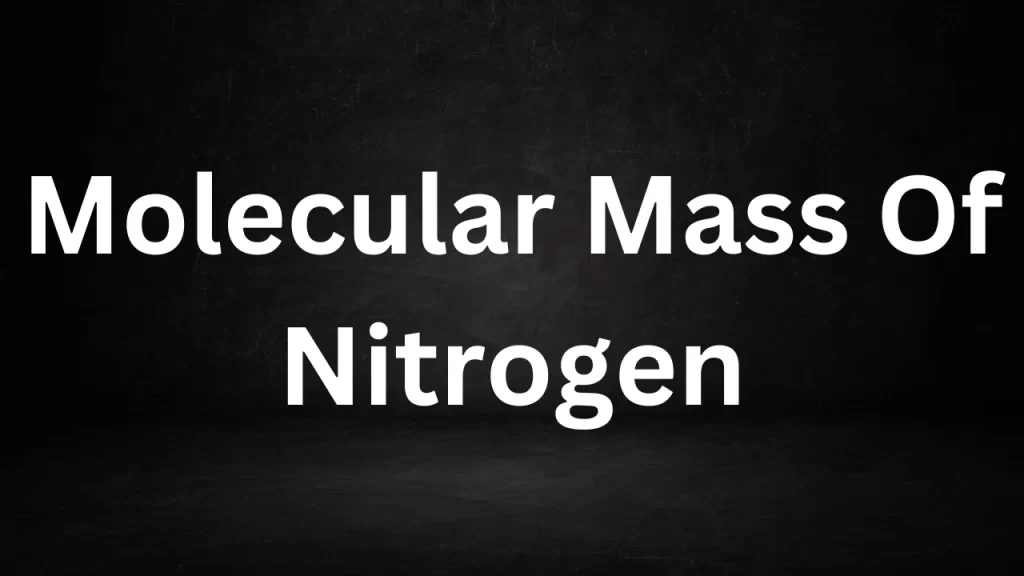
Molecular Mass Of Nitrogen
The Basics of Molecular Mass
Molecular mass, also known as molecular weight or molar mass, is a fundamental concept in chemistry. It is defined as the mass of a molecule, which is the sum of the masses of all the atoms in that molecule.
The unit of molecular mass is the unified atomic mass unit (u), which is defined relative to the mass of a carbon-12 atom. The molecular mass of a compound is typically expressed in atomic mass units.
The Composition of Nitrogen Molecule
In the case of N2, the most common and stable form found in nature is the N2 molecule (N2). This molecule consists of two nitrogen atoms bonded together by a strong triple covalent bond. To determine the molecular mass of N2, we need to consider the individual masses of the nitrogen atoms that compose it.
Atomic Mass of Nitrogen
The atomic mass of an element is the weighted average of the masses of its naturally occurring isotopes. Nitrogen has two stable isotopes, nitrogen-14 (14N) and nitrogen-15 (15N), with natural abundances of approximately 99.63% and 0.37%, respectively.
The atomic mass of nitrogen-14 is approximately 14.00307 atomic mass units (u), and the atomic mass of nitrogen-15 is approximately 15.00011 u.
Calculating the Molecular Mass of Nitrogen (N2)
Now that we know the atomic masses of N2 isotopes, we can calculate the molecular mass of nitrogen (N2). Since there are two N2 atoms in an N2 molecule, we simply add the masses of these two atoms together:
Molecular Mass of N2 = (Atomic Mass of Nitrogen-14) x 2
Molecular Mass of N2 ≈ (14.00307 u) x 2 ≈ 28.00614 u
Rounded to four decimal places, the molecular mass of nitrogen (N2) is approximately 28.0061 atomic mass units (u).
Significance of Nitrogen’s Molecular Mass
Understanding the molecular mass of nitrogen is crucial in various scientific and industrial applications. For instance:
- Chemical Reactions: Chemists use molecular masses to balance chemical equations and determine reaction stoichiometry, which helps in predicting the amounts of reactants and products.
- Gas Properties: The molecular mass of N2 is important in understanding its physical properties, including its behavior as a gas in various conditions and its role in gas mixtures.
- Environmental Science: Researchers use the molecular mass of N2 to study N2 cycles and its impact on ecosystems, as well as its contribution to air pollution.
- Industrial Processes: In industries such as food processing and electronics manufacturing, the molecular mass of N2 is critical for controlling and optimizing production processes.
- Aviation and Space Exploration: Engineers and scientists consider the molecular mass of N2 in the design and operation of aircraft and spacecraft, as N2 is a significant component of the atmosphere.
- In conclusion, the molecular mass of nitrogen (N2), which is approximately 28.0061 atomic mass units (u), is a fundamental property of this essential element.
- It plays a pivotal role in various scientific and industrial fields, contributing to our understanding of chemistry, physics, and the natural world.
Read More
- Molecular Weight Of Glucose
- Molecular Mass Of Oxygen
- Difference Between Light Microscope And Electron Microscope
- Molar Mass Of Aluminium
- Molecular Mass Of Glucose
Frequently Asked Questions (FAQs) Molecular Mass Of Nitrogen
1. What is the molecular mass of nitrogen (N2)?
The molecular mass of nitrogen (N2) is approximately 28.0061 atomic mass units (u). This value is calculated by adding the atomic masses of the two N2 atoms that compose the N2 molecule.
2. Why is it important to know the molecular mass of nitrogen?
Knowing the molecular mass of N2 is essential in various scientific and industrial applications. It helps chemists balance chemical equations, understand gas properties, study environmental impacts, and optimize industrial processes.
3. How is the molecular mass of N2 calculated?
The molecular mass of nitrogen (N2) is calculated by adding the atomic masses of the two N2 atoms in the molecule. Since there are two nitrogen atoms, you simply multiply the atomic mass of nitrogen by 2.
4. What are the isotopes of N2, and how do they affect its molecular mass?
N2 has two stable isotopes: nitrogen-14 (14N) and N2-15 (15N). These isotopes have slightly different atomic masses. The molecular mass of N2 takes into account the weighted average of these isotopes based on their natural abundances, resulting in a molecular mass of approximately 28.0061 u.
5. How does nitrogen’s molecular mass impact its behavior as a gas?
The molecular mass of N2 influences its physical properties as a gas. It affects factors such as density, boiling point, and solubility. Nitrogen’s molecular mass plays a role in its behavior in various gas mixtures and its importance in industrial applications.
},{
“@type”: “Question”,
“name”: “4. What are the isotopes of nitrogen, and how do they affect its molecular mass?”,
“acceptedAnswer”: {
“@type”: “Answer”,
“text”: “Nitrogen has two stable isotopes: nitrogen-14 (14N) and nitrogen-15 (15N). These isotopes have slightly different atomic masses. The molecular mass of nitrogen takes into account the weighted average of these isotopes based on their natural abundances, resulting in a molecular mass of approximately 28.0061 u.”
}
},{
“@type”: “Question”,
“name”: “5. How does nitrogen’s molecular mass impact its behavior as a gas?”,
“acceptedAnswer”: {
“@type”: “Answer”,
“text”: “The molecular mass of nitrogen influences its physical properties as a gas. It affects factors such as density, boiling point, and solubility. Nitrogen’s molecular mass plays a role in its behavior in various gas mixtures and its importance in industrial applications.”
}
}]
}
Molecular Weight Of Glucose
Molecular Weight Of Glucose: The molecular weight of glucose (C6H12O6) can be calculated by adding together the atomic weights of all its constituent atoms. The atomic weights are usually given in atomic mass units (amu) or unified atomic mass units (u).
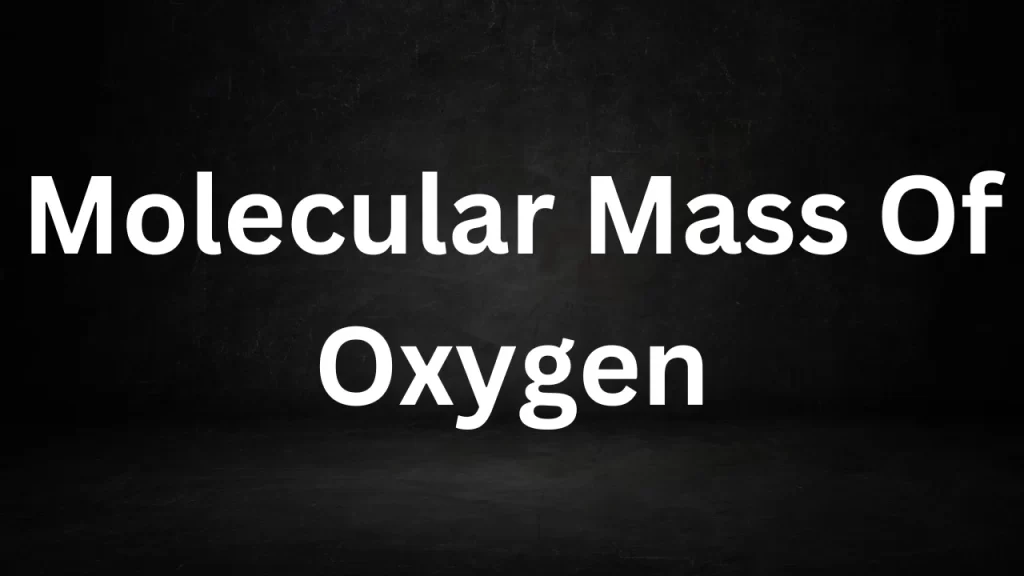
Molecular Weight Of Glucose
Here’s how to calculate the molecular weight of C6H12O6:
- Carbon (C) has an atomic weight of approximately 12.01 u.
- Hydrogen (H) has an atomic weight of approximately 1.01 u.
- Oxygen (O) has an atomic weight of approximately 16.00 u.
Now, let’s calculate the molecular weight:
Molecular Weight of C6H12O6 = (6 * Atomic Weight of Carbon) + (12 * Atomic Weight of Hydrogen) + (6 * Atomic Weight of Oxygen)
Molecular Weight of C6H12O6 = (6 * 12.01 u) + (12 * 1.01 u) + (6 * 16.00 u)
Molecular Weight of C6H12O6 = 72.06 u + 12.12 u + 96.00 u
Molecular Weight of C6H12O6 ≈ 180.18 u
So, the molecular weight of glucose (C6H12O6) is approximately 180.18 unified atomic mass units (u) or atomic mass units (amu).
This value is often used in chemistry for various calculations and is expressed in grams per mole (g/mol) in the International System of Units (SI). Therefore, the molar mass of C6H12O6 is approximately 180.18 g/mol.
Read More
- Molecular Mass Of Oxygen
- Difference Between Light Microscope And Electron Microscope
- Molar Mass Of Aluminium
- Molecular Mass Of Glucose
- Latent Heat Of Water
Frequently Asked Question (FAQs) Molecular Weight Of C6H12O6
1. What is the molecular weight of C6H12O6?
The molecular weight of glucose (C6H12O6) is approximately 180.18 unified atomic mass units (u) or atomic mass units (amu).
2. How is the molecular weight of C6H12O6 calculated?
The molecular weight of C6H12O6 is calculated by adding together the atomic weights of all its constituent atoms. Carbon (C) has an atomic weight of approximately 12.01 u, hydrogen (H) has an atomic weight of approximately 1.01 u, and oxygen (O) has an atomic weight of approximately 16.00 u.
3. Why is knowing the molecular weight of glucose important in chemistry and biology?
The molecular weight of C6H12O6 is crucial in various scientific and practical applications. It is used in chemistry for stoichiometry, reaction calculations, and molar concentration calculations. In biology, it’s important for understanding metabolic processes and cellular energy production.
4. Is the molecular weight of C6H12O6 the same as its molar mass?
Yes, the molecular weight of C6H12O6 is often referred to as its molar mass. Both terms represent the mass of one mole of glucose molecules (C6H12O6) and are expressed in grams per mole (g/mol).
5. How is the molecular weight of C6H12O6 used in analytical chemistry and laboratory work?
In analytical chemistry, the molecular weight of C6H12O6 is used to determine the concentration of C6H12O6 solutions. It’s also used to calculate the amount of glucose in chemical reactions or biological samples.
Molecular Mass Of Oxygen
Molecular Mass Of Oxygen: O2, often symbolized as O2, is the life-sustaining element that makes up a substantial portion of Earth’s atmosphere. Its importance in respiration, combustion, and various chemical processes is undeniable.
To fully grasp the significance of oxygen, it’s essential to understand its molecular mass, a fundamental property that reveals its weight and behavior in the natural world.
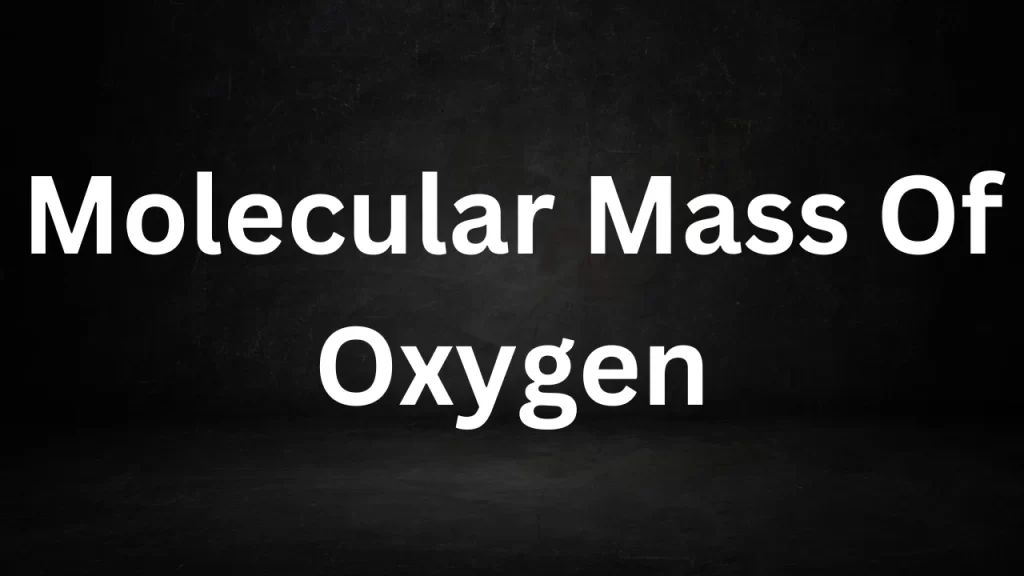
Molecular Mass Of Oxygen
Defining Molecular Mass
Molecular mass, also known as molecular weight or molar mass, is a measure of the total mass of a molecule. In the case of O2, this refers to the combined mass of the two O2 atoms that form a diatomic molecule. Molecular mass is typically expressed in atomic mass units (amu) or grams per mole (g/mol).
Calculating the Molecular Mass of Oxygen (O2)
To determine the molecular mass of O2, we must consider the atomic masses of the individual O2 atoms. The atomic mass of an element is defined relative to the mass of a carbon-12 atom, which is assigned a mass of exactly 12 atomic mass units (amu).
The atomic mass of O2 is approximately 15.9994 amu. Since O2 molecules consist of two O2 atoms, we can calculate the molecular mass of O2 as follows:
Molecular Mass of O2 = (Atomic Mass of O) * 2
Molecular Mass of O2 = (15.9994 amu) * 2
Molecular Mass of O2 ≈ 31.9988 amu
Hence, the molecular mass of O2 is approximately 31.9988 atomic mass units.
The Significance of Molecular Mass
Understanding the molecular mass of O2 is crucial in various scientific and practical applications:
1. Respiration:
- In the field of biology, the molecular mass of O2 is essential for calculating the amount of O2 consumed during respiration. This information is vital for understanding metabolic processes in organisms.
2. Stoichiometry:
- Chemists use molecular masses extensively in stoichiometry, where they calculate reactant and product masses in chemical reactions. This knowledge helps in determining reaction yields and balancing chemical equations.
3. Gas Laws:
- In the study of gases, such as in the ideal gas law, the molecular mass of O2 is a key parameter for predicting gas behavior under various conditions of temperature and pressure.
4. Environmental Science:
- Molecular mass plays a role in environmental studies, including air quality assessments. It helps in determining the composition of Earth’s atmosphere and monitoring changes due to pollution.
5. Industry and Technology:
- In industrial processes like combustion, the molecular mass of O2 is essential for optimizing fuel-air mixtures and ensuring efficient energy production.
Conclusion
The molecular mass of O2 is approximately 31.9988 atomic mass units, revealing its weight in chemical reactions, biological processes, and everyday applications.
This fundamental property allows scientists, engineers, and researchers to better understand and harness the power of O2, a vital element for life on Earth and an essential component in the world of chemistry and physics.
Read More
- Difference Between Light Microscope And Electron Microscope
- Molar Mass Of Aluminium
- Molecular Mass Of Glucose
- Latent Heat Of Water
- Difference Between Work And Power
Frequently Asked Question (FAQs) Molecular Mass Of Oxygen
1. What is the molecular mass of oxygen (O2)?
The molecular mass of oxygen (O2) is approximately 31.9988 atomic mass units (amu).
2. How is the molecular mass of oxygen calculated?
The molecular mass of oxygen (O2) is calculated by adding together the atomic masses of its constituent O2 atoms. Since O2 atoms have an atomic mass of approximately 15.9994 amu, the molecular mass of O2 is 2 times this value (2 * 15.9994 amu).
3. Why is knowing the molecular mass of oxygen important?
Understanding the molecular mass of O2 is essential in various scientific and practical applications. It is used in biology to calculate O2 consumption during respiration, in chemistry for stoichiometry and reaction balancing, and in environmental science for air quality assessments, among other uses.
4. Is the molecular mass of oxygen the same as its molar mass?
Yes, the molecular mass of O2is often referred to as its molar mass. Both terms refer to the mass of one mole of O2 molecules (O2), expressed in grams per mole (g/mol) or atomic mass units (amu).
5. How does the molecular mass of oxygen impact chemical reactions involving oxygen?
The molecular mass of O2 is crucial in chemical reactions where O2 is a reactant or product. It helps determine reactant and product masses, stoichiometry, and reaction yields.